Active mode Operation of BJT | Analog and Digital Electronics - Electrical Engineering (EE) PDF Download
When a transistor is in the fully-off state (like an open switch), it is said to be cutoff. Conversely, when it is fully conductive between emitter and collector (passing as much current through the collector as the collector power supply and load will allow), it is said to be saturated. These are the two modes of operation explored thus far in using the transistor as a switch.
However, bipolar transistors don’t have to be restricted to these two extreme modes of operation. As we learned in the previous section, the base current “opens a gate” for a limited amount of current through the collector. If this limit for the controlled current is greater than zero but less than the maximum allowed by the power supply and load circuit, the transistor will “throttle” the collector current in a mode somewhere between cutoff and saturation. This mode of operation is called the active mode.
Cut-off, Saturation and Active Mode
An automotive analogy for transistor operation is as follows:
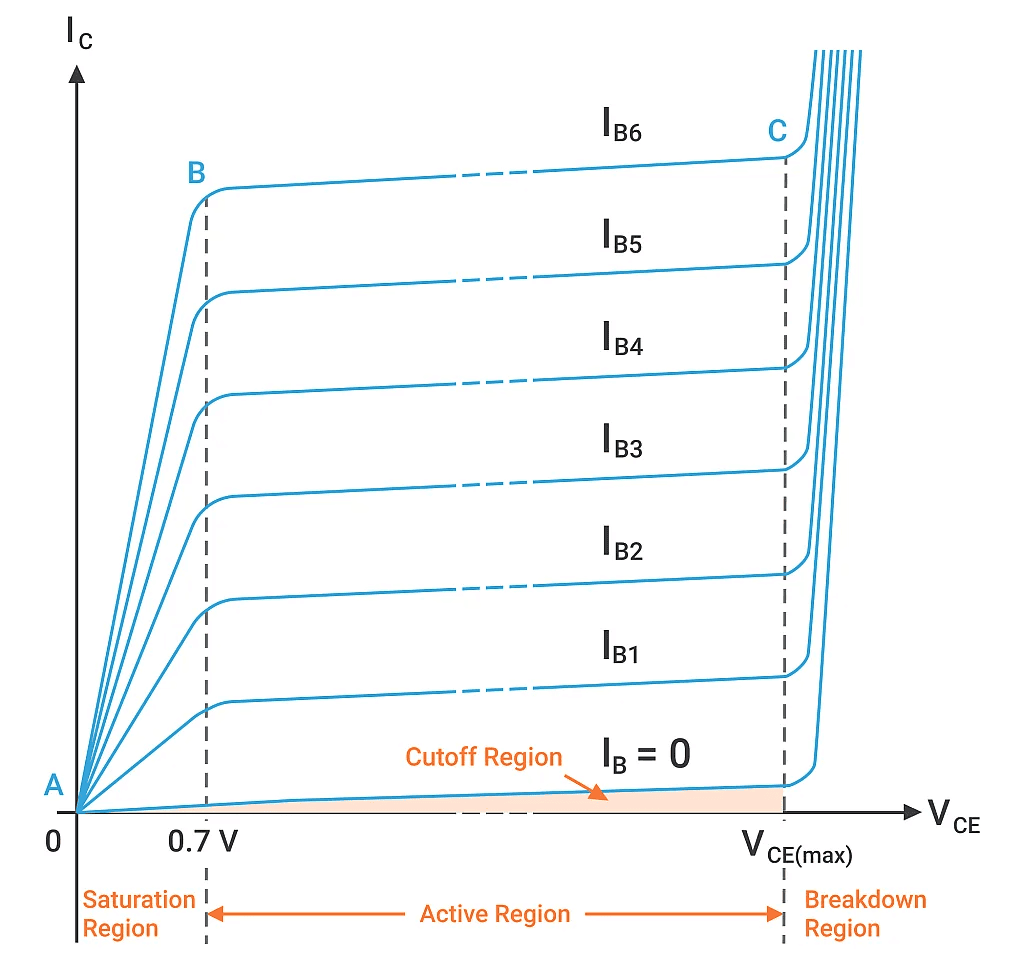
Cut-off mode - is the condition of no motive force generated by the mechanical parts of the car to make it move. In cutoff mode, the brake is engaged (zero base current), preventing motion (collector current).
Active mode - is the automobile cruising at a constant, controlled speed (constant, controlled collector current) as dictated by the driver.
Saturation - the automobile driving up a steep hill that prevents it from going as fast as the driver wishes. In other words, a “saturated” automobile is one with the accelerator pedal pushed down (base current calling for more collector current than can be provided by the power supply/load circuit).
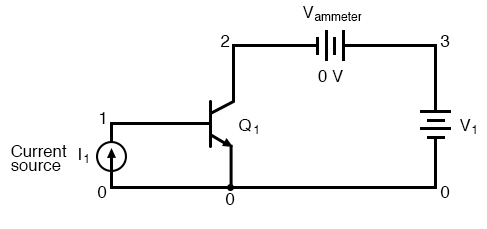
A current source is a device that outputs a specific amount of current, generating as much or as little voltage across its terminals to ensure that the exact amount of current through it. Current sources are notoriously difficult to find in nature (unlike voltage sources, which by contrast attempt to maintain a constant voltage, outputting as much or as little current in the fulfillment of that task), but can be simulated with a small collection of electronic components. As we are about to see, transistors themselves tend to mimic the constant-current behavior of a current source in their ability to regulate current at a fixed value.
BJT Basic Circuit Analysis
Now let’s look at and analyze the basic BJT circuit in figure as we are going to use a circuit similar to it later to understand the operating regions of a BJT. As we can see we have two external bias voltage sources, VBB and VCC, and two resistors, RB and RC. We can also see three important DC voltages across the transistor junctions, VBE, VCE, and VCB, and three DC currents, IB, IC, and IE.


The external bias voltage VBB forward-biases the base-emitter junction. The base-emitter junction as you can see in figure 3 is like a diode. So when it is forward-biased it will have a voltage drop across it similar to a diode, approximately 0.7V or higher. But to simplify things, we will just use 0.7V. So in the circuit, the voltage is designated as VBE.

By Kirchoff’s voltage law, the voltage across RB is:

And by Ohm’s law, the voltage across RB is also:

So,

Rearranging the equation, we can get the equation for the DC base current for this BJT circuit:

Using Kirchoff’s voltage law again, we can get the voltage at the collector with respect to the emitter which is equal to VCC minus the voltage drop across RC:



Now, to get the voltage across the collector-base junction, we need to subtract the voltage at the collector and the voltage across the base which in this circuit is VCE and VBE. So VCB is:

Take note that the collector here is n-type while the base is p-type. If the collector is at a higher voltage than the base, the collector-base junction will be reverse-biased. On the other hand, if the collector is at a lower voltage than the base, then the collector-base junction will be forward-biased.
Characteristics
The voltage/current relationship of a transistor is entirely different from what we’re used to seeing across a resistor. With a resistor, current increases linearly as the voltage across it increases. Here, with a transistor, current from emitter to collector stays limited at a fixed, maximum value no matter how high the voltage across the emitter and collector increases.
Often it is useful to superimpose several collector current/voltage graphs for different base currents on the same graph as in the figure below. A collection of curves like this—one curve plotted for each distinct level of base current—for a particular transistor is called the transistor’s characteristic curves:

Collector current versus collector-emitter voltage for various base currents.
Each curve on the graph reflects the collector current of the transistor, plotted over a range of collector-to-emitter voltages, for a given amount of base current. Since a transistor tends to act as a current regulator, limiting collector current to a proportion set by the base current, it is useful to express this proportion as a standard transistor performance measure. Specifically, the ratio of collector current to base current is known as the Beta ratio (symbolized by the Greek letter β):
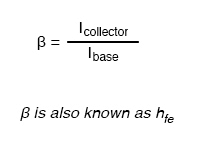
Sometimes the β ratio is designated as “hfe,” a label used in a branch of mathematical semiconductor analysis known as “hybrid parameters” which strives to achieve precise predictions of transistor performance with detailed equations. Hybrid parameter variables are many, but each is labeled with the general letter “h” and a specific subscript. The variable “hfe” is just another (standardized) way of expressing the ratio of collector current to base current, and is interchangeable with “β.” The β ratio is unitless.
β for any transistor is determined by its design: it cannot be altered after manufacture. It is rare to have two transistors of the same design exactly match because of the physical variables affecting β. If a circuit design relies on equal β ratios between multiple transistors, “matched sets” of transistors may be purchased at extra cost. However, it is generally considered bad design practice to engineer circuits with such dependencies.
The β of a transistor does not remain stable for all operating conditions. For an actual transistor, the β ratio may vary by a factor of over 3 within its operating current limits. For example, a transistor with advertised β of 50 may test with Ic/Ib ratios as low as 30 and as high as 100, depending on the amount of collector current, the transistor’s temperature, and frequency of the amplified signal, among other factors. For tutorial purposes it is adequate to assume a constant β for any given transistor; realize that real life is not that simple!
Sometimes it is helpful for comprehension to “model” complex electronic components with a collection of simpler, better-understood components. The model in the figure below is used in many introductory electronics texts.
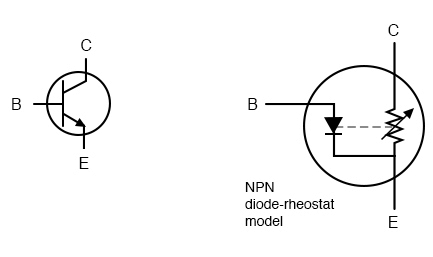
Elementary diode-resistor transistor model.
This model casts the transistor as a combination of diode and rheostat (variable resistor). Current through the base-emitter diode controls the resistance of the collector-emitter rheostat (as implied by the dashed line connecting the two components), thus controlling collector current. An NPN transistor is modeled in the figure shown, but a PNP transistor would be only slightly different (only the base-emitter diode would be reversed).
This model succeeds in illustrating the basic concept of transistor amplification: how the base current signal can exert control over the collector current. However, the model miscommunicates the notion of a set amount of collector-emitter resistance for a given amount of base current. If this were true, the transistor wouldn’t regulate collector current at all as the characteristic curves show. Instead of the collector current curves flattening out after their brief rise as the collector-emitter voltage increases, the collector current would be directly proportional to collector-emitter voltage, rising steadily in a straight line on the graph.
A better transistor model, often seen in more advanced textbooks, is shown in figure below.
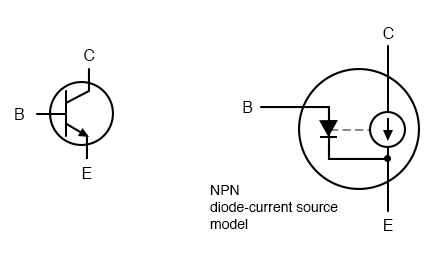
Current source model of transistor.
It casts the transistor as a combination of a diode and current source, the output of the current source being set at a multiple (β ratio) of the base current. This model is far more accurate in depicting the true input/output characteristics of a transistor: base current establishes a certain amount of collector current, rather than a certain amount of collector-emitter resistance as the first model implies. Also, this model is favored when performing network analysis on transistor circuits, the current source being a well-understood theoretical component. Unfortunately, using a current source to model the transistor’s current-controlling behavior can be misleading: in no way will the transistor ever act as a source of electrical energy. The current source does not model the fact that its source of energy is an external power supply, similar to an amplifier.
|
135 videos|181 docs|71 tests
|
FAQs on Active mode Operation of BJT - Analog and Digital Electronics - Electrical Engineering (EE)
| 1. What is the cut-off region in BJT operation? |  |
| 2. What is saturation mode in BJT operation? |  |
| 3. What is active mode operation of a BJT? |  |
| 4. How do you determine if a BJT is in active mode? |  |
| 5. What are the key characteristics of BJT active mode operation? |  |
















